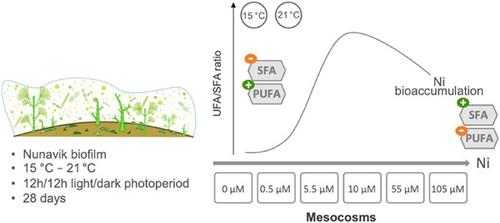当前位置:
X-MOL 学术
›
Environ. Toxicol. Chem.
›
论文详情
Our official English website, www.x-mol.net, welcomes your feedback! (Note: you will need to create a separate account there.)
Influence of Temperature and Nickel on Algal Biofilm Fatty Acid Composition.
Environmental Toxicology and Chemistry ( IF 4.1 ) Pub Date : 2020-05-04 , DOI: 10.1002/etc.4741 Mariem Fadhlaoui 1 , Vincent Laderriere 1 , Isabelle Lavoie 1 , Claude Fortin 1
Environmental Toxicology and Chemistry ( IF 4.1 ) Pub Date : 2020-05-04 , DOI: 10.1002/etc.4741 Mariem Fadhlaoui 1 , Vincent Laderriere 1 , Isabelle Lavoie 1 , Claude Fortin 1
Affiliation

|
Freshwater biofilms play an important role in aquatic ecosystems and are widely used to evaluate environmental conditions. Little is known about the effects of temperature and metals on biofilm fatty acid composition. In the present study, we exposed a natural biofilm cultured in mesocosms to a gradient of nickel (Ni) concentrations at 15 and 21 °C for 28 d. Metal bioaccumulation, algal taxonomic composition, and biofilm fatty acid profiles were determined. At both temperatures, bioaccumulated Ni increased with Ni exposure concentration and reached the highest values at 25 µM Ni, followed by a decrease at 55 and 105 µM Ni. In control biofilms, palmitic acid (16:0), palmitoleic acid (16:1n7), oleic acid (18:1n9), linoleic acid (18:2n6), and linolenic acid (18:3n3) were the dominant fatty acids at 15 and 21 °C. This composition suggests a dominance of cyanobacteria and green algae, which was subsequently confirmed by microscopic observations. The increase in temperature resulted in a decrease in the ratio of unsaturated to saturated fatty acids, which is considered to be an adaptive response to temperature variation. Polyunsaturated fatty acids (PUFAs) tended to decrease along the Ni gradient, as opposed to saturated fatty acids which increased with Ni concentrations. Temperature and Ni affected differently the estimated desaturase and elongase activities (product/precursor ratios). The increase in PUFAs at 15 °C was concomitant to an increase in Δ9‐desaturase (D9D). The estimated activities of D9D, Δ12‐desaturase, and Δ15‐desaturase decreased along the Ni gradient and reflected a decline in PUFAs. The elevated estimated elongase activity reflected the observed increase in saturated fatty acids at the highest Ni exposure concentration (105 µM). Our results suggest that fatty acids could be used as an endpoint to evaluate environmental perturbations. Environ Toxicol Chem 2020;39:1566–1577. © 2020 SETAC
中文翻译:

温度和镍对藻类生物膜脂肪酸组成的影响。
淡水生物膜在水生生态系统中起着重要作用,被广泛用于评估环境条件。关于温度和金属对生物膜脂肪酸组成的影响知之甚少。在本研究中,我们将中膜培养的天然生物膜暴露于15和21°C的镍(Ni)浓度梯度下28 d。确定金属的生物蓄积,藻类分类组成和生物膜脂肪酸谱。在这两个温度下,随着镍暴露浓度的增加,生物积累的镍增加,在25 µM Ni时达到最高值,然后在55和105 µM Ni时下降。在对照生物膜中,棕榈酸(16:0),棕榈油酸(16:1n7),油酸(18:1n9),亚油酸(18:2n6)和亚麻酸(18:3n3)是主要的脂肪酸15和21°C。这种成分表明蓝藻和绿藻占主导地位,随后通过显微镜观察证实了这一点。温度的升高导致不饱和脂肪酸与饱和脂肪酸的比率降低,这被认为是对温度变化的适应性响应。多不饱和脂肪酸(PUFA)倾向于沿着Ni梯度下降,而饱和脂肪酸则随着Ni浓度的增加而增加。温度和镍对估计的去饱和酶和延伸酶活性(产物/前体比)的影响不同。15°C下PUFA的增加与Δ9去饱和酶(D9D)的增加同时发生。D9D,Δ12去饱和酶和Δ15去饱和酶的估计活性沿Ni梯度下降,反映了PUFA的下降。估计的延长酶活性升高,反映了在最高的镍暴露浓度(105 µM)下观察到的饱和脂肪酸增加。我们的结果表明,脂肪酸可以用作评估环境扰动的终点。2020年《环境毒理学》; 39:1566–1577。©2020 SETAC
更新日期:2020-05-04
中文翻译:

温度和镍对藻类生物膜脂肪酸组成的影响。
淡水生物膜在水生生态系统中起着重要作用,被广泛用于评估环境条件。关于温度和金属对生物膜脂肪酸组成的影响知之甚少。在本研究中,我们将中膜培养的天然生物膜暴露于15和21°C的镍(Ni)浓度梯度下28 d。确定金属的生物蓄积,藻类分类组成和生物膜脂肪酸谱。在这两个温度下,随着镍暴露浓度的增加,生物积累的镍增加,在25 µM Ni时达到最高值,然后在55和105 µM Ni时下降。在对照生物膜中,棕榈酸(16:0),棕榈油酸(16:1n7),油酸(18:1n9),亚油酸(18:2n6)和亚麻酸(18:3n3)是主要的脂肪酸15和21°C。这种成分表明蓝藻和绿藻占主导地位,随后通过显微镜观察证实了这一点。温度的升高导致不饱和脂肪酸与饱和脂肪酸的比率降低,这被认为是对温度变化的适应性响应。多不饱和脂肪酸(PUFA)倾向于沿着Ni梯度下降,而饱和脂肪酸则随着Ni浓度的增加而增加。温度和镍对估计的去饱和酶和延伸酶活性(产物/前体比)的影响不同。15°C下PUFA的增加与Δ9去饱和酶(D9D)的增加同时发生。D9D,Δ12去饱和酶和Δ15去饱和酶的估计活性沿Ni梯度下降,反映了PUFA的下降。估计的延长酶活性升高,反映了在最高的镍暴露浓度(105 µM)下观察到的饱和脂肪酸增加。我们的结果表明,脂肪酸可以用作评估环境扰动的终点。2020年《环境毒理学》; 39:1566–1577。©2020 SETAC


























 京公网安备 11010802027423号
京公网安备 11010802027423号